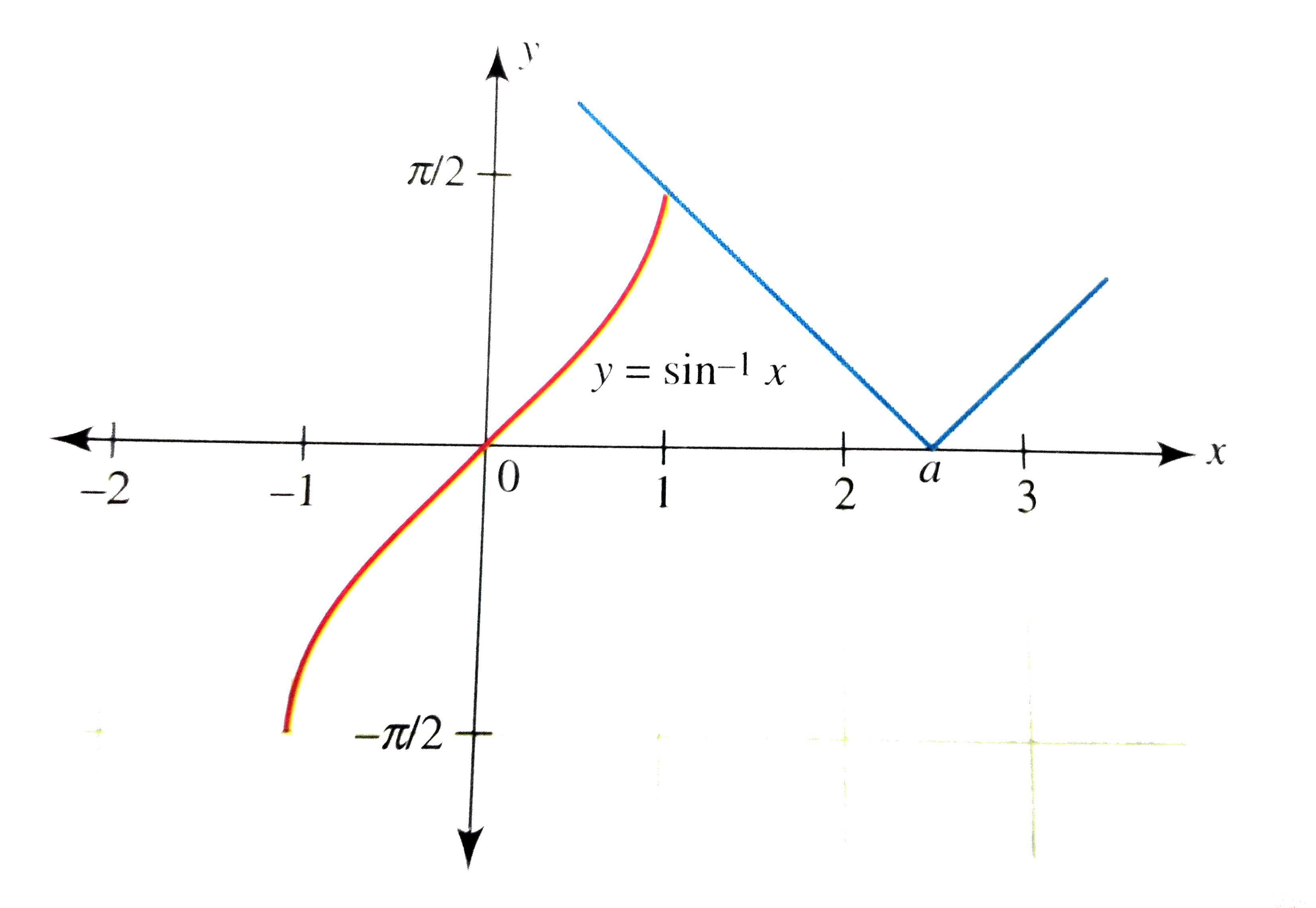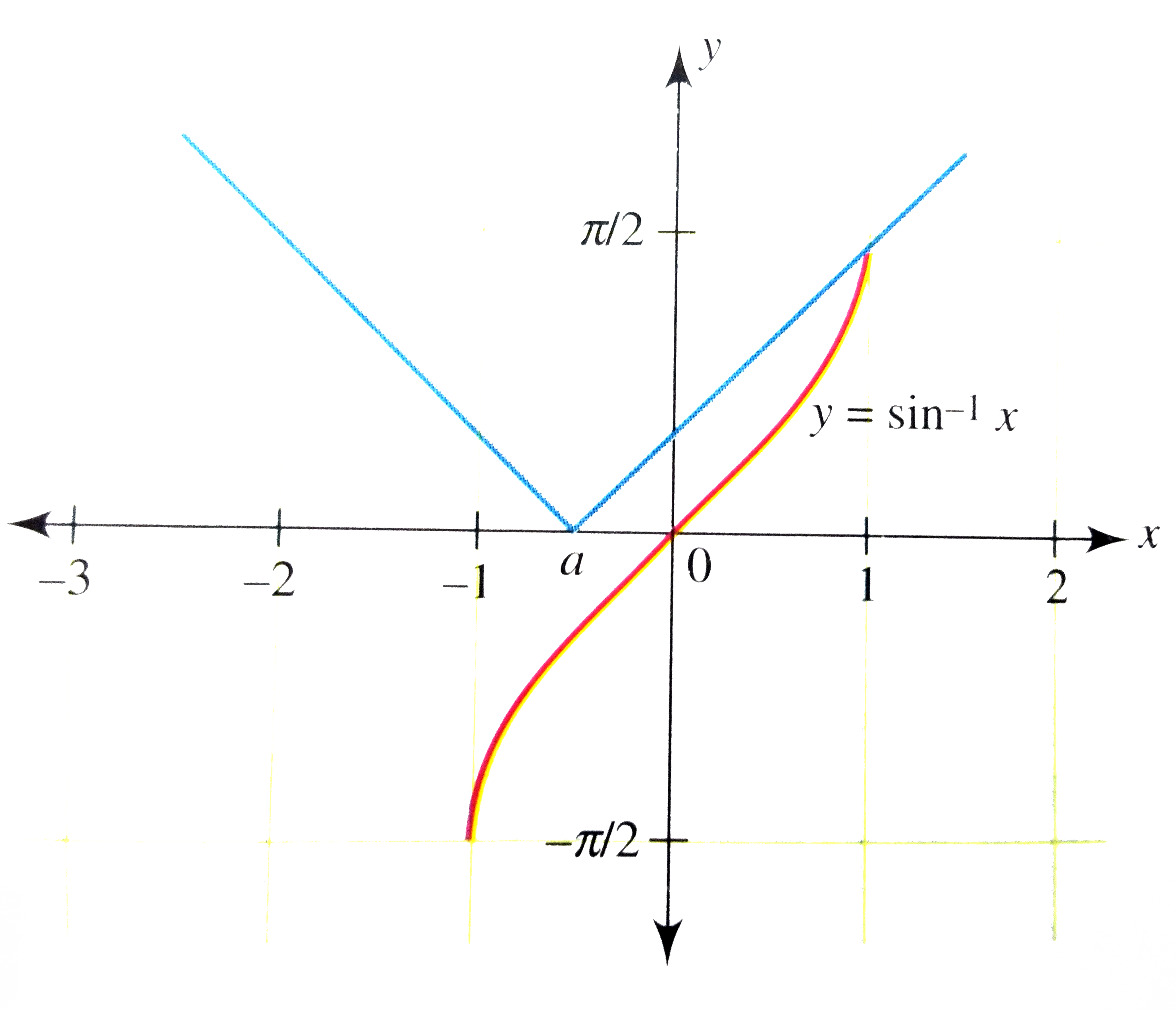Explore topic-wise InterviewSolutions in .
This section includes InterviewSolutions, each offering curated multiple-choice questions to sharpen your knowledge and support exam preparation. Choose a topic below to get started.
| 101. |
Let bar(a) = 2bar(i) + 3bar(j) + bar(k), bar(b) = 4bar(i) + bar(j) and bar(c ) = bar(i) - 3bar(j) -7bar(k). Find the vector bar(r )such that bar(r ).bar(a) = 9, bar(r ).bar(b) = 7 and bar(r ).bar(c ) =6. |
|
Answer» |
|
| 102. |
Critical points of y=a log x + bx^(2)+x are x=-1 and x = 2. Then find a and b. |
|
Answer» |
|
| 103. |
Find the values of a for whch sin^*(-1)x=|x-a| will have at least one solution. |
Answer» Solution : (i) When `alt0` In this CASE, y = a-x MUST pass through `(1,pi/2)` `thereforepi/2=a-1rArra=1+pi/2` (II) When `alt0`  In this case, `y=x-a" must pass THOUGH "(1,pi/2)` `pi/2=1-a` `a=1-pi/2` For at least on solution. `1-pi/2leale1+pi/2` |
|
| 104. |
Find the vector equation of the line that passes through the points (3,-2,-5)and(3,-2,6) |
|
Answer» `barr=hati+2hatj+3hatk+lambda(3hati-2hatj-5hatk)` |
|
| 105. |
If the normals at the four points (x_1,y_1),(x_2,y_2),(x_3,y_3) and (x_4,y_4) on the ellipse x^(2)/a^(2)+y^(2)/b^(2)=1 are concurrent. Prove that (x_1+x_2+x_3+x_4)((1/x_1+1/x_2+1/x_3+1/x_4)=4 |
| Answer» | |
| 107. |
If a**b = a +b - abon Q^(+) , then the identity and the inverse of a for ** are respectively .......... |
|
Answer» `0 and (a)/(a-1)` |
|
| 108. |
If A=[{:(0,-1,2),(4,3,-4):}]andB=[{:(4,0),(1,3),(2,6):}]then verify that : (i) (A')=A (ii)(A*B)'=B'*A' (iii)(kA)'=(k*A') |
|
Answer» |
|
| 109. |
In the physics lab, a student determined the kinetic energy, KE, of an object at various velocities, V, and found a strong positive association between KE and V. Which of the above scatterplots show this relationship? |
|
Answer» GRAPH (1) |
|
| 110. |
Examine thatf(x) = sin |x| is a continuous function. |
|
Answer» |
|
| 111. |
Find all the three digit numbers for which one obtains when dividing the number by 11, the sum of the squares of the digits of the initials. |
|
Answer» |
|
| 112. |
Let ABCD be a parallelogram whose equations for the diagonals AC and BD are x+2y=3 and 2x+y=3, respectively. The length of side AB is equal to |
|
Answer» `2sqrt(58)//3` `"or " -(4)/(5) = (4+(100//9)-AB^(2))/(2 xx 2 xx (10//3))` `"or " AB = (2sqrt(58))/(3)` |
|
| 113. |
Write the vale of intxa^(x^(2+1))dx |
| Answer» SOLUTION :`INTXA^(x^2+1)dx=1/2inta^tdt` (Where`x^2+1=timplies2xdx=dt) =a^t/(2Ina)+C` | |
| 114. |
Equation to the circles which pass through the point (2,3) and cut off equal chords of length 6 units along the lines y-x-1=0 and y+x-5=0 is |
|
Answer» `(x-3)^2+(y-2sqrt3)^2=(3sqrt2)^2` |
|
| 115. |
If z_(1), z_(2), z_(3) , z_(4) are the affixes of the vertices of a parallelogram taken in order in Argand plane, then |
|
Answer» `z_(1)+z_(3)=z_(2)+z_(4)` |
|
| 116. |
If the system of linear equations above has o solution, and a is a constant, then what is the value of a ? |
|
Answer» `-2` |
|
| 118. |
If the d.c.'s (l, m, n) of two lines are connected by the relations l+m+n=0 " and " 2mn+3ln-5lm=0 then the angle between the lines is |
|
Answer» `pi//4` |
|
| 119. |
Find the number of positive integral solutions of x_(1)x_(2)x_(3)=54 where x_(1),x_(2),x_(3)ne1 |
|
Answer» |
|
| 120. |
Match the following. {:(,"List -I",,"List-II",),(,"(Differential equation)",,"(Order O, Degree = D)",),((1),[((dy)/(dx))^(3)+(d^(2)y)/(dx^(2))]^(2) = a(dy)/(dx),(a),2O + 3D = 8,),((2),3y = 7x(dy)/(dx)+(5)/(dy//dx),(b),O^(D)+D^(O) = 4,),((3),(d^(2)y)/(dx^(2)) - 5(dy)/(dx)+6y = 0,(c) ,O=D,),((4),((dy)/(dx)+4x)^(3//2) = x+5(dy)/(dx),(d),3^(O)+2^(D) = 11,):} The correct match from List-I from List -II |
|
Answer» 1-a, 2-C, 3-b, 4-d |
|
| 121. |
There are three bags B_1,B_2 and B_3. The bag B_1 contains 5 red and 5 green balls, B_2 contains 3 red 5 green balls, and B_3 contains 5 red and 3 green balls. Bags B_1, B_2 and B_3 have probabilities (3)/(10),(3)/(10) and (4)/(10) respectively of being chosen. A bag is selected at random and a ball is chosen at random form the bag. then which of the following options is/are correct ? |
|
Answer» Probability that the CHOSEN ball is green, GIVEN that the selected bag is `B_3` equals `(3)/(8)`. It is given that there are three bags, `B_1,B_2` and `B_3` and probabilities of being chosen, `B_1,B_2 and B_3` are RESPECTIVELY. `THEREFORE P(B_1)=(3)/(10),P(B_2)=(3)/(10) and P(B_3)=(4)/(10)` Now, probability that the chosen ball is green, given that selected bag is `B_3P((G)/(B_3))=(3)/(8)` Now, probability that the chosen selected bag is `B_3`, given that the chosen ball is green `=P((B_3)/(G))` `=(P((G)/(B_3))P(B_3))/(P((G)/((B_1))P(B_1))+P((G)/(B_2))P(B_2)+P((G)/(B_3))P(B_2))["by Baye's theorem"]` `=(((3)/(8)xx(4)/(10)))/(((5)/(10)xx(3)/(10))+((5)/(8)xx(3)/(10))+((3)/(8)xx(4)/(10)))=((1)/(2))/((1)/(2)+(5)/(8)+(1)/(2))=(4)/(13)` Now, probability that the chosen ball is green `=P(G)=P(B_1)P((G)/(B_1))+P(B_2)P((G)/(B_2))+P(B_3)P((G)/(B_3))` [By using theorem of total probability] `=((3)/(10)xx(5)/(10))+((3)/(10)xx(5)/(8))+((4)/(10)xx(3)/(8))` `=(3)/(20)+(3)/(16)+(3)/(20)=(12+15+12)/(80)=(39)/(80)` Now, probability that the selected bag is `B_3` and the chosen ball is green `=P(B_3)xxP((G)/(B_3))=(4)/(10)xx(3)/(8)=(3)/(20)` Hence, OPTIONS (a) and (c) is are correct. |
|
| 124. |
If O is the origin and A is (a, b, c), then find the direction cosines of the line OA and the equation of plane through A at right angle to OA. |
|
Answer» |
|
| 126. |
Findthe value of a,b,cand d. [{:(a,3a-b),(2a+c,3b-d):}]=[{:(3,2),(7,7):}] |
|
Answer» |
|
| 128. |
If a line has direction cosines 2/3,-1/3,-2/3, then find its direction. |
|
Answer» |
|
| 129. |
If side of a cube is 10 cm and error in it is 0.05 cm then match the following {:("I.","Error in surface are of cube","a",15),("II".,"Percentage error in surface area",b,6),("III.","Error in volume",c,1.5),("IV.","Percentage error in volume",d,0.05),("","",e,1):} |
| Answer» Answer :D | |
| 130. |
If a,b,c are three consevutive terms of an AP and x,y,z are three consecutive terms of a GP, then the value of X^(b-c).Y^(c-a). Z^(a-b) is |
|
Answer» 1)0 |
|
| 131. |
Evaluate the following determinates |{:(sin10^@,-cos10^@),(sin80^@, cos80^@):}| |
|
Answer» |
|
| 132. |
If ABCD is a cyclic quadrilateral with AB = 6, BC = 4, CD = 5, DA= 3 and angleABC = theta ,then cos theta= |
|
Answer» A`(3)/(13)` |
|
| 133. |
A circle having centre as O' and radius r' touches the incircle of Delta ABC externally at. F, where F is on BC and also touches its circumcircle internally at G. It O is the circumcentre of Delta ABC and I is its incentre, then |
|
Answer» OO'=R-r'  `OE=DE=|BF-BD|=|s-b-(a)/(2)|=(|c-b|)/(2)` OD = EF = R cos A From `Delta OEO'`, using Pythagoras theorem, we get `(R-r')^(2)=(R cos A+r')^(2)+((c-b)/(2))^(2)` `rArr r' =(BC)/(4R)"tan"^(2)(A)/(2)` `= (Delta)/(a)"tan"^(2)(A)/(2)` |
|
| 134. |
The value of ("sin"(2019pi)/2-cos2019pi)/("tan"(2020pi)/3) is |
|
Answer» 1 |
|
| 135. |
Differentiate cotx^2 |
|
Answer» SOLUTION :LET `y=cotx^2` Then `dy/dx=-"COSEC"^2x^2xxd/dx(x^2)` `=-"cosec"^2x^2 cdot2x` `=-2xcdot "cosec"^2x^2` |
|
| 136. |
int_(0)^(pi/4) sin 2x dx |
|
Answer» SOLUTION :`" Let I "= int_(0)^(pi//4) sin 2 x dx` `=int_(0)^(pi//4) 2 sin x COSX dx ` `UNDERSET(x=0 ""rArr t=sin 0=0)underset(x=(pi)/(4) ""rArr t= sin.(pi)/(4) =(1)/(SQRT(2)))("Letsin "x=t ""rArr cosx dx =dt)` `:. I=2 int_(0)^(pi//sqrt(2))t dt = 2 [(t^(2))/(2)]_(0)^(1//sqrt(2))` `=((1)/(sqrt(2)))^(2)=(1)/(2)` |
|
| 137. |
Let u,v,w be rela numbers in geometric progression such that u gt v gt w. Suppose u ^(40)= v ^(n) = w ^(60). Find the value of n . |
|
Answer» |
|
| 138. |
Refers to question 27. Maximum of Z occurs at |
|
Answer» (5,0) |
|
| 139. |
Integrate thefunction in Exercise. (x^(3)-1)^((1)/(3))x^(5) |
| Answer» | |
| 140. |
If x(hat(i) + hat(j) + hat(k)) is a unit vector then x equals ? |
|
Answer» `(1)/(SQRT(3))` |
|
| 141. |
The sum to n terms of the series 1 + (1 + 3) + (1 + 3 + 9) + (1 + 3 + 9 + 27)+ .......... is |
|
Answer» `(3(3^(n) - 1))/4 - 1` |
|
| 142. |
Centre and radius of the circle with segment of the line x+y=1 cut off by coordinate axes as diameter is |
|
Answer» `(1/2,1/2),1/(SQRT(2))` |
|
| 143. |
The order and degree of the differential equation [((dy)/(dx))^(2) + ((d^(2)y)/(dx^(2)))]^(5//4) = k (d^(3) y)/(dx^(3)) is |
|
Answer» 1,2 |
|
| 144. |
Integrate the following functions : intcosecx.log(cossex-cotx)dx |
|
Answer» |
|
| 145. |
Let Abe a square matrix of order 3xx3, then |KA| is equalto |
|
Answer» ` K|A| ` |
|
| 146. |
If f:RtoRandg:RtoR are given by f(x)=cosxandg(x)=3x^(2). Find gof and fog. |
|
Answer» |
|
| 147. |
int_(0)^(pi//2)x sin x dx = |
|
Answer» 0 |
|
| 148. |
{:(I."The points" i + j + k. 4i + 3j "and" 10 i + 7j - 2k "are", a. a xx b = 7c),(II. "The vectors" 5i + 5j + 7k. 7i - 8j + k "and" i - 20 j - 5k "are",b. "collincar"),(III. a = 2i + 3j + 6k. b = 3i - 6j + 2k, c. "non-coplanar"),(IV. "The Points" 2i - j + k. i - 3j = 5k "and" 3i - 4j - 4k "are", d."vertices of equilateral triangle"),(, e. "vertices of right angled triangle"):} |
| Answer» Answer :A | |
| 149. |
If the vectors veca = 2hati + 3hatj +-6hatk and vecb = alphahati-hatj +2hatk are parallel, then alpha = ______ |
|
Answer» 2 |
|
| 150. |
Find the non-parametric form of vector equation, and Cartesian equation vector equation, and Cartesian equation of the plane passing through the point (0, 1,-5) and parallel to the straight linesvecr=(hati=2hatj-4hatk)+s(2hati+3hatj+6hatk)andvecr=(hati=3hatj-4hatk)+t(hati+hatj+hatk) |
|
Answer» |
|